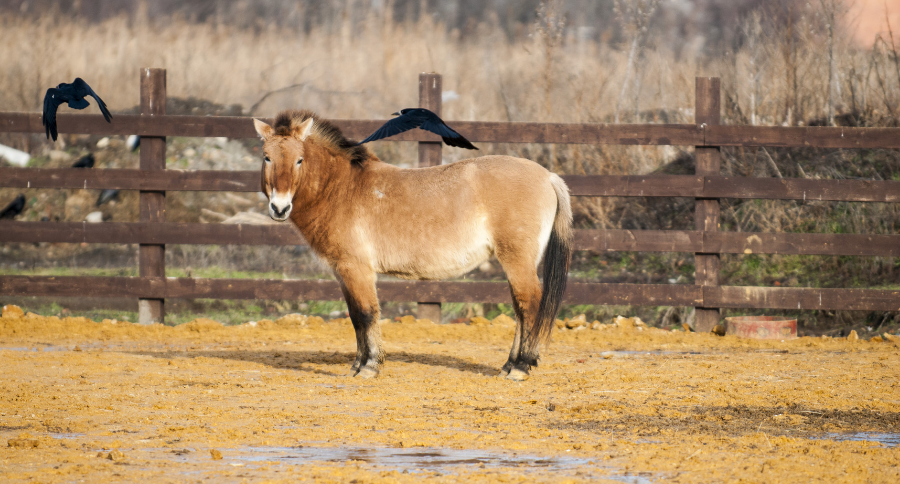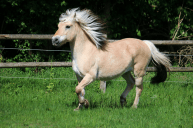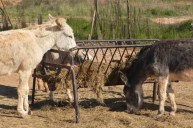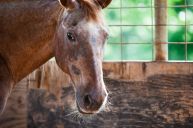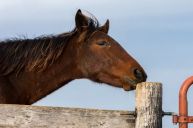Przewalski's horses, critically endangered horses found in Mongolia, are the last truly wild horse. Prior to reintroduction programs, Przewalski's horses were last seen in the wild during the 1960s in the Gobi Desert. Once thought to be the ancestor to the domestic horse, they are actually distant cousins. Mitochondrial DNA suggests that they diverged from a common ancestor 500,000 years ago. They bear a remarkable resemblance to the horse but Przewalski horses' have a smaller, stockier frame and a zebra-like mane.
The adorable four Przewalski's horse foals joined the herd at the Smithsonian Conservation Biology Institute (SCBI). According to Dolores Reed, an animal caretaker at SCBI, nearly three decades have passed since four of these foals have frolicked together in the fields of SCBI at once. Reed goes on to say that the colts have not yet begun to show many distinct personality traits, but a few hints of their future temperaments are already emerging!

Smithsonian Magazine tells us,
"These horses, named for the Russian explorer who first scientifically described them, are sometimes referred to as "p-horses" in lieu of the full Przewalski (pronounced sha-VAL-ski).
Native to Mongolia, China and Kazakhstan, Przewalski's horses are listed as "endangered" by the International Union for Conservation of Nature. They were once extinct in the wild, and all the Przewalski's horses alive today are descended from 14 individuals."
Thanks to the SCBI site, we have some fun facts about the p-horses,
- Przewalski's horses are called "takhi," which means "spirit" in Mongolia.
- They have 66 chromosomes, compared to the 64 that domestic horses have.
- Today they can only be found in reintroduction sites in Mongolia, China, and Kazakhstan. Clearly, this horse species is designed to live in harsh winters.
- What's the wild population of Przewalski today? About 1,900 of these horses are still alive today, and small numbers are being slowly reintroduced into the wild in Mongolia.
- The legs of Przewalski's horse are often faintly striped with a dark stripe, also typical of primitive markings.
- The Przewalski's horse (Khalkha Mongolian: Equus przewalskii or Equus caballus przewalskii, Equus ferus przewalskii), is also called the Mongolian wild horse or Dzungarian horse.
- Ancient climate change per research wiped out a number of Central Asia mammals and some groups of wild horses.
A small number of Przewalski's horses were scattered about in various zoos around Europe and the United States. Credit for the preservation of the Przewalski's horse goes to Prague Zoo, which in 1959 was charged with managing the international studbook for the species. This zoo, in particular, had a major role in the protection of the Przewalski.
In the late 1980s, the reintroductions and breeding programs were run mainly by Dutch, German, and Swiss organizations. Although captive breeding was unsuccessful.
Do you want to know more about the Central Asian Przewalski's Horse? Given it is the very last surviving wild horse species, making sure this endangered species survives is a priority for all of us!
The Foundation for the Preservation and Protection of the Przewalski Horse is a wonderful resource. Wild Przewalski's horses have a lot of support fortunately and Le Villaret, located in the Cevennes National Park in southern France and run by the Association Takh, is another breeding site for Przewalski's horses that was created to allow the free expression of natural Przewalski's horse behaviors. (We're so happy the study of behavior is part of the breeding program).
An intensely researched population of these free-ranging animals was also introduced to the Hortobágy National Park puszta in Hungary, and data gathered from these animals are used to improve the Mongolian conservation effort. We will follow the efforts of all these organizations and keep readers posted with adorable foal images.
Are you familiar with Przewalski's horses? Did you know they were critically endangered horses? Please leave us a comment below.
WATCH NOW: 10 Most Popular Horse Breeds in the World
